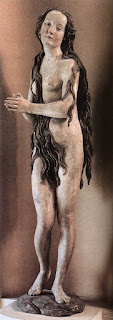 |
| Jules Joseph Lebebvre |
 |
| After Pompeo Batoni |
As we have often said, and you have often heard, she was not a prostitute, nor was she Mary of Bethany, nor was she even a "sinner" except insofar as we are all sinners. At least Scripture does not tell us so. Nor, by the same standard, do we have reason to believe that she retired to a cave to live out a life of penitence, whether in Britain or France or anywhere else. Even the story of the reddening egg (alas!) is pure myth. (Much less the Da Vinci Code balderdash.)
| Robert Lenz |
A pity, really. The legends of Mary Magdalene, in their full medieval glory, compose a treasury of beautiful and exotic speculation, adorned by a vast gallery of painting and sculpture. They are adventurous, sexy, pious and at the same time just a little subversive. For many people, it is these legends -- these exotic speculations -- that are the Magdalene's chief attraction. (Here's an introduction).
 |
| Gregor Erhart |
Mind you, the little that we actually learn from Scripture is interesting enough. Jesus cast "seven devils" from her, she was part of the group of women who provided for the disciples out of their own living, and of the smaller group who had been "healed of evil spirits and infirmities." Above all, she is the one figure placed by all of the four Evangelists at the empty Easter tomb.
The significance of this is hard to overstate. Few figures are mentioned by name in all four gospels; not the Blessed Virgin, nor her husband, nor some of the Twelve. It leads some scholars to speculate that the Magdalene, as perhaps also John the Baptist, may have been a spiritual leader of some independent authority, whose followers (and whose story) were gradually integrated into the master-narrative of the Jesus movement. This may well be a feminist fantasy -- but it is no less plausible than her retirement to a Provencal cavern.
 |
| AA Ivanov |
What we can rely on, however, is this: that she was a central figure in the story of the Resurrection -- the first witness, and the first to carry the story. The Orthodox are right to identify her as one of the Myrrh-Bearing Women, but this does not go nearly far enough. She is rightly called Apostle to the Apostles, and -- although this is rarely mentioned -- a model for preachers, for all those who share the good news of the Resurrection, for all those who proclaim a Christianity with new life at its center.

No comments:
Post a Comment